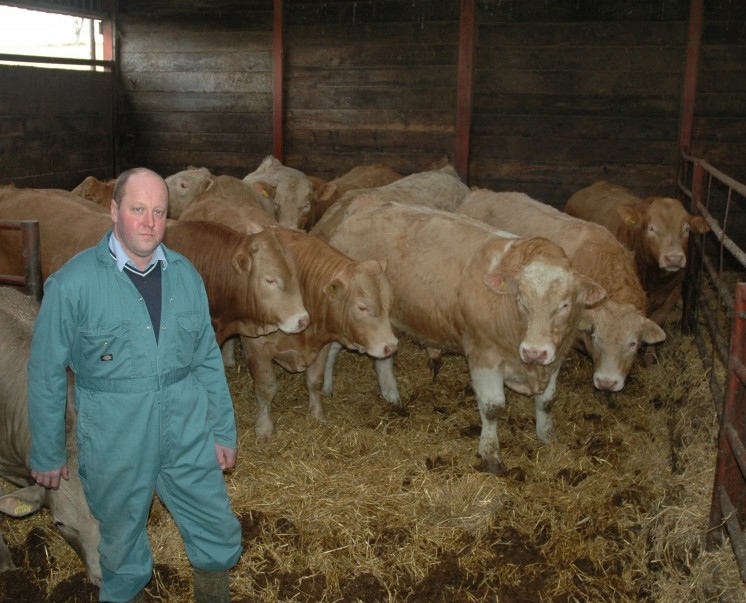Cumbrian beef producer, Mark Bowman is focused on maximising output per suckler cow and has found that he has been able to boost annual income by over £200 a head by simply swapping terminal sires for Charolais.
Mark Bowman of Crinkledyke with his Charolais sired progeny
“Our main objective for our cattle enterprise is to rear calves with a big carcase because there’s no disputing – weight pays, and then finish the entire crop as efficiently as possible,” Mark explains.
“We use a mix of markets – both live and dead. At present all cattle are sold liveweight through the ring at Penrith mart with buyers providing feedback on carcase data – it’s a useful exercise and helps to identify where we can make further improvements to selecting more carefully our genetics as well as management. A Charolais cross heifer made 270p per kg liveweight (£1,650) at the mart’s Easter prime show.
“We’ve tried and tested three crops of Charolais sired calves and they’ve certainly lived up to our expectations. Take the bulls, they’re finishing on average eight weeks earlier and killing out 30kg heavier than our other continental crosses, while our biggest surprise has been the heifers, in particular their quality – they’re long, clean and have good conformation and they’re reaching an average 400kg in 20 months.” The entire crop of bulls and heifers are fed an identical diet at the same rate. See table 1.
Table 1: Cringledyke finished cattle average performance
|
Charolais cross |
Continental cross |
|||
|
Bulls |
Heifers |
Bulls |
Heifers |
|
| Days to slaughter |
450 |
600 |
510 |
600 |
| Weight (kg) |
440 |
400 |
410 |
370 |
Source: Cringledyke
Those performance benefits delivered by the Charolais cross bulls are leaving Mr Bowman an additional income of more than £300 a head over the continental crosses, when taking in the current 380p per kg average market price (R4L) and 350p per day costs. In addition, the Charolais cross heifers are delivering an extra £100.
Mark Bowman farms Cringledyke, Kirkoswald, a 500 acre hill unit including 100 acres of cereals and 30 acres of roots, and carrying 115 suckler cows and followers plus 1,150 ewes. All progeny are taken through to finishing. The unit is farmed in a family partnership – Mark and his wife, Julie and parents, Maurice and Pat.
Finishing homebred bulls and heifers on home grown grain has been key to Mark’s strategy for the last 20 years, and it’s one that he continues to tweak while keeping the system as simple as possible.
Introducing Charolais as the herd’s terminal sire was a relatively recent decision. “We were seeking to breed and rear an animal with a big frame on which to grow muscle – we want to exploit size and weight and we decided to invest in Charolais five years ago having watched how the breed had evolved since it was originally introduced to the county more than 40 years ago. It has developed more muscle, has a favourable temperament, and we believed there was the potential to exploit hybrid vigour using him over our continental cross dairy suckler cows.
“Over 80% of the herd is scheduled to calve in spring and the remainder autumn in order to spread the workload and cash flow,” he says. “We carefully select milky cows, ones that will provide sufficient milk for their calves through to September when we introduce creep, a mix based on home grown barley.”
Weaned calves are housed in November, bulls averaging 350kg and heifers 270kg. The bulls are introduced to the finishing diet, a 14% CP barley mix. The Charolais crosses are finishing at 15 months and an average 440kgs, killing out at 58% and within the U 3,4L specification, while the heifers are overwintered on silage plus 2kg a head of barley based home mix, grazed the following summer and then rehoused and finished at an average 19 months; they kill out similar to the bulls and all grade -U or better.
He adds: “We are proud of our beef enterprise which is producing a high quality and fully traceable product, as efficiently as possible. Making just one change by introducing Charolais to the herd has certainly helped to improve our efficiencies and we’re continually fine tuning. In fact we’re working away here not just for ourselves, but we would also like to make sure the opportunities are available for our two young sons, Arthur and Jack to eventually secure a farming future.”
Categories: Commercial, News
Welshpool Charolais bulls peak at 7,200gns » « The 2009, 2010, 2011 Calf Crops (Beef Focus article)
